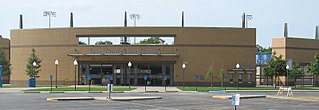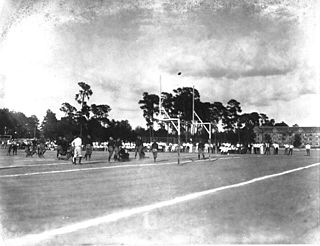
San Diego Stadium was a multi-purpose stadium in San Diego, California. The stadium opened in 1967 as San Diego Stadium and was known as Jack Murphy Stadium from 1981 to 1997. From 1997 to 2017, the stadium's naming rights were owned by Qualcomm, and the stadium was known as Qualcomm Stadium or simply The Q. The naming rights expired on June 14, 2017, and were purchased by San Diego County Credit Union, renaming the facility as SDCCU Stadium on September 19, 2017; those naming rights expired in December 2020. Demolition of San Diego Stadium began in December 2020, with the last freestanding section of the stadium's superstructure felled by March 22, 2021.

Yogi Berra Stadium is a baseball stadium in Little Falls, New Jersey, on the campus of Montclair State University. The stadium is home to the Montclair State Red Hawks baseball team, which competes in NCAA Division III; the NJIT Highlanders baseball team which competes in NCAA Division I; and the Yogi Berra Museum and Learning Center, which adjoins the stadium on its first base side. It was formerly home to the New Jersey Jackals of the independent Frontier League.

Cameron Indoor Stadium is an indoor arena located on the campus of Duke University in Durham, North Carolina. The 9,314-seat facility is the primary indoor athletic venue for the Duke Blue Devils and serves as the home court for Duke men's and women's basketball and women's volleyball. It opened in January 1940 and was known as Duke Indoor Stadium until 1972, when it was named for Eddie Cameron, who served at Duke as men's basketball coach from 1928 to 1942, as football coach from 1942 to 1945, and as athletic director from 1951 to 1972. The arena is located adjacent to its predecessor, Card Gymnasium, which opened in 1930.

Durham Athletic Park, nicknamed "The DAP", is a former minor league baseball stadium in Durham, North Carolina. The stadium was home to the Durham Bulls from 1926 through 1994, the North Carolina Central Eagles and the Durham School of the Arts Bulldogs. The DAP sits north of the downtown area of Durham, on the block bounded by Washington, Corporation, Foster and Geer Streets.

Durham Bulls Athletic Park is a 10,000-seat ballpark in Durham, North Carolina, that is home to the Durham Bulls, the Triple-A affiliate of the Tampa Bay Rays of Major League Baseball. It is also home to the Duke Blue Devils and North Carolina Central Eagles college baseball teams. The $18.5-million park opened in 1995 as the successor to Durham Athletic Park.

Wallace Wade Stadium, in full Brooks Field at Wallace Wade Stadium, is a 40,004-seat outdoor stadium in the southeastern United States, located on the campus of Duke University in Durham, North Carolina. Primarily used for American football, it is the home field of the Duke Blue Devils of the Atlantic Coast Conference.

The Duke Blue Devils are the intercollegiate athletic teams that represent Duke University, located in Durham, North Carolina. Duke's athletics department features 27 varsity teams that all compete at the National Collegiate Athletic Association (NCAA) Division I level. The name comes from the French "les Diables Bleus" or "the Blue Devils," which was the nickname given during World War I to the Chasseurs Alpins, the French Alpine light infantry battalion.

The Duke Blue Devils football team represents Duke University in the sport of American football. The Blue Devils compete in the Football Bowl Subdivision (FBS) of the National Collegiate Athletic Association (NCAA) and the Coastal Division of the Atlantic Coast Conference (ACC). The program has 17 conference championships, 53 All-Americans, 10 ACC Players of the Year, and have had three Pro Football Hall of Famers come through the program. The team is coached by Manny Diaz and play their home games at Wallace Wade Stadium in Durham, North Carolina.

Hawkins Field is a baseball stadium in Nashville, Tennessee. It is the home field of the Vanderbilt Commodores college baseball team. The stadium opened in 2002 adjacent to Vanderbilt Stadium and Memorial Gymnasium and holds 3,700 people. In 2010, the Nashville Outlaws, a collegiate summer baseball team of the Prospect League, used Hawkins Field as their home ballpark.

Gene Hooks Stadium was a baseball stadium in Winston-Salem, North Carolina. It was the primary home field of the Wake Forest Demon Deacons baseball program from 1981 through 2008.
The 2000 Major League Baseball season ended with the New York Yankees defeating the New York Mets in five games, for their third consecutive World Series title. The 2000 World Series was known as the Subway Series because both fans and the two teams could take the subway to and from every game of the series.

Jackie Robinson Stadium is a college baseball park in Los Angeles, California. It is the home field of the UCLA Bruins of the Pac-12 Conference. Opened 43 years ago in 1981, it is the smallest ballpark in the conference, with a seating capacity of 1,820. It is named after former Bruin athlete Jackie Robinson, the first African-American major league baseball player of the modern era.

The Bryant Bulldogs are the athletic teams representing Bryant University in Smithfield, Rhode Island. As of July 1, 2022, the Bulldogs compete in most National Collegiate Athletic Association (NCAA) Division I sports as members of the America East Conference (AmEast). The move to the AmEast followed a 14-year tenure in the Northeast Conference (NEC), which it joined in 2008 when it began a transition from NCAA Division II to Division I. Bryant's largest rivalry during its Division II years was Bentley College, both founders of the Northeast-10 Conference (NE-10) and both have prominent business programs. Bryant University athletics started out as a member of the National Association of Intercollegiate Athletics (NAIA) before it transitioned into Division II. Bryant competed in the NE-10 from the conference's founding in 1980 until 2008 when the university began the transition to Division I. In 2012, Bryant became a full Division I member.

The City Game is an annual college basketball game between the University of Pittsburgh Panthers and the Duquesne University Dukes. The term "City Game" is also used refer to women's basketball games played annually between the two universities and may also be used to refer to other athletic competitions between the two schools.

Clay Gould Ballpark, the home field of the UT Arlington Mavericks, is located on the campus of The University of Texas at Arlington. The stadium has a seat capacity of 1,600. Clay Gould Ballpark is located at the intersection of West Park Row Drive and Fielder Road.
A total of twenty-nine sports venues were used for the 1996 Summer Olympics.

Albertsons Stadium is an outdoor athletic stadium in the western United States, located on the campus of Boise State University in Boise, Idaho. It is the home field of the Boise State Broncos of the Mountain West Conference. Known as Bronco Stadium for its first 44 seasons, it was renamed in May 2014 when Albertsons, a chain of grocery stores founded by Boise area resident Joe Albertson, purchased the naming rights.

Fleming Field was the first on-campus home for the football and baseball teams representing the University of Florida in Gainesville. Construction began in 1910, and the facility debuted as the home field for Florida Gators outdoor sports programs during the spring semester of the 1910-1911 academic year.
The 1952 Duke Blue Devils baseball team represented Duke University in the 1952 NCAA baseball season. The Blue Devils played their home games at Jack Coombs Field. The team was coached by Jack Coombs in his 24th year at Duke.
The University of South Florida athletic facilities are the stadiums and arenas the South Florida Bulls use for their home games and training. The University of South Florida currently sponsors 19 varsity athletic teams and has 11 facilities in the designated Athletics District on or adjacent to its Tampa campus, one on its St. Petersburg campus, and one elsewhere in Tampa. 18 of the 19 teams have some sort of facility in the USF Athletics District.


















